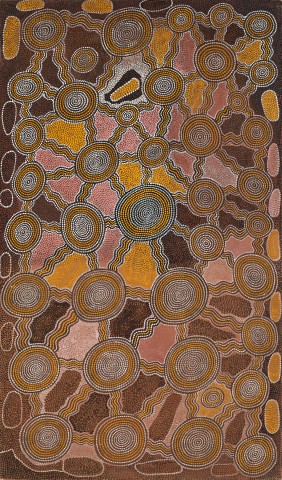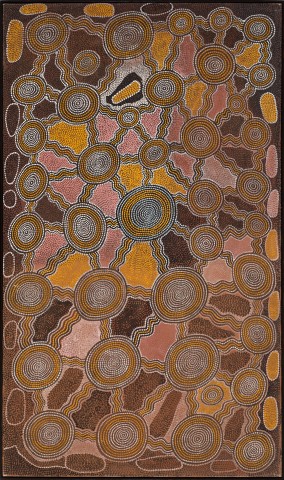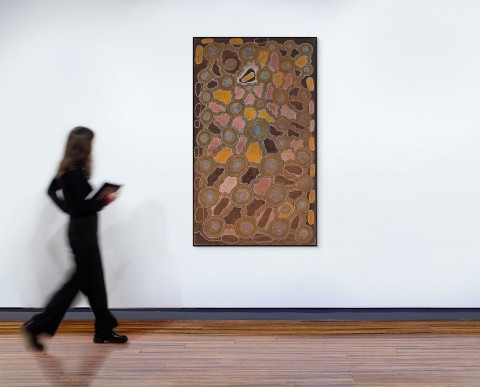TINGARRI AT KAMPANGUTJANANYA, 1978
FREDDY WEST TJAKAMARRA
synthetic polymer paint on linen
171.5 x 100.5 cm
bears inscription verso: Papunya Tula Artists cat. FW781104
Papunya Tula Artists, Alice Springs, Northern Territory
Aboriginal Arts Board, Australia Council, Sydney
The Kelton Collection, USA, acquired from the above
Private collection, Switzerland
Private collection, Melbourne
Past and Present Art of the Australian Aborigines, from The Kelton Foundation Collection, Pacific Asia Museum, Pasadena, California, 24 September 1980 – 4 January 1981
Dreamtime: Art of the Australian Aborigine, Pt. 1 Land and Tradition, California State University, Northridge, California, 12 September – 14 October 1988
Abstract Reality: Australian Dreamtime Art, Modern Museum of Art, Santa Ana, California, 17 January – 16 April 1989
The Evolving Dreamtime: Contemporary Art by Indigenous Australians-Part I, Pacific Asia Museum, Pasadena, California, 3 August 1994 – 22 January 1995
This painting is accompanied by a copy of the certificate of authenticity from Papunya Tula Artists which states:
'The Mythological travels of a group of Tingari Men to the lake site Kampangutjanganynga far, far to the west of Alice Springs are celebrated in this depiction. The Tingari is a mytho-ritual complex or series of traditions of deep religious significance. They are widely distributed through the Western Desert and are basically secret-sacred. For this reason, details relating to Tingari myths, songs and rituals may not be publicly revealed.
In this particular episode, the Tingari had come from the north east and had camped at Kampangutjanganya in order to hold ceremonies of instruction for the post initiate novices or Maliki with whom they were travelling. Here they met a lone old man. While camped at this site they prepared seed cakes for the Maliki. These seed cakes were prepared from the ground flour of the wild grasses of the area.
A bushfire suddenly emerged and the Tingari Men were forced to cut short their stay and flee to the south west.
All the sets of concentric circles indicate specific sites in the vicinity of Kampangutjanganya, such as the place where the Tingari met the old man, the camps where the Maliki were held during their instruction and the place where the seed cake was made. The interconnecting sinuous lines indicate the paths of the Tingari between these various sites. The areas enclosed by the main configuration (with the exception of one) indicates the water on the lakes surface. The area (marked on the diagram) represents the stone on which the seeds were ground into flour for the damper. The black dots that surround the composition indicate Tjiparinypa, the grass from which the seeds were collected.'


